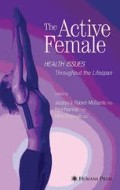Abstract
After completing this chapter, you should have an understanding of the following:
-
• The difference between moderate physical activity, vigorous physical activity, exercise, health-related physical fitness, and sports-related fitness.
-
• Physical activity recommendations for health-related fitness from leading health organizations.
-
• The American College and Sports Medicine’s (ACSM’s) exercise recommendations for cardiorespiratory fitness.
-
• The ACSM’s exercise recommendations for muscular fitness.
-
• The ACSM’s exercise recommendations for healthy body composition.
-
• The ACSM’s exercise recommendations for flexibility.
Access this chapter
Tax calculation will be finalised at checkout
Purchases are for personal use only
Preview
Unable to display preview. Download preview PDF.
References
United States Department of Health and Human Services. Healthy People 2010: Understanding and Improving Health, 2nd ed. Washington, DC: U.S. Government Printing Office, November 2000.
Physical Activity and Cardiovascular Health. NIH Consensus Statement Online 1995 December 18–20[cited January 17, 2006]; 13(3): 1–33.
Pate RR, Pratt M, Blair SN, et al. Physical activity and public health. A recommendation from the Centers for Disease Control and Prevention and the American College of Sports Medicine. JAMA 1995;273:402–407.
U.S. Department of Health and Human Services. Physical activity and health: a report of the surgeon general. Atlanta, GA: Centers for Disease Control and Prevention (CDC), National Center for Chronic Disease Prevention and Health Promotion, 1996.
Franco O, De Laet C, Peeters A, et al. Effects of physical activity on life expectancy with cardiovascular disease. Arch Intern Med 2005;165:2355–2360.
Ainsworth B, Haskell WL, Whitt MC, et al. Compendium of physical activities: an update of activity codes and MET intensities. Med Sci Sports Exerc 2000;32(9):S498–S516.
American College of Sports Medicine. ACSM’s Guidelines for Exercise Testing and Prescription, 7th ed. Philadelphia, PA: Lippincott Williams & Wilkins, 2006.
Dwyer G, Davis S. ACSM’s Health-Related Physical Fitness Assessment Manual. Philadelphia, PA: Lippincott Williams & Wilkins, 2004.
Keteyian S, Brawner C. Cardiopulmonary adaptations to exercise. In: Kaminsky LK, ed. ACSM’s Resource Manual for Guidelines for Exercise Testing and Prescription, 5th ed. Philadelphia, PA: Lippincott Williams & Wilkins, 2006:313–324.
Pollock ML, Gaesser GA, Butcher JD. The recommended quantity and quality of exercise for developing and maintaining cardiorespiratory and muscular fitness, and flexibility in healthy adults. Med Sci Sports Exerc 1998;30:975–991.
Falk B, Tenenbaum G. The effectiveness of resistance training in children. A meta-analysis. Sports Med 196;22:176–186.
Hurley BF, Hagberg JM, Goldberg AP, et al. Resistance training can reduce coronary risk factors without altering VO2max or percent body fat. Med Sci Sports Exerc 1988;20:150–154.
Kerr D, Morton A, Dick I, et al. Exercise effects on bone mass in postmenopausal women are site-specific and load-dependent. J Bone Miner Res 1996;11:218–225.
Nelson M, Wernick S. Strong Women Stay Young. New York: Bantam Books, 2000.
Faigenbaum A, Pollock ML, Ishida Y. Prescription of resistance training for health and disease. Med Sci Sports Exerc 1996;28:1311–1320.
American College of Sports Medicine Position Stand. Progression models in resistance training in healthy adults. Med Sci Sports Exerc 2002;34:364–380.
Hoeger WW, Barette SL, Hale DR. Relationship between repetitions and selected percentages of one repetition maximum. J Appl Sport Sci Res 1987;1(1):11–13.
Dragenich LF, Jarger RT, Kradji AR. Coactivation of hamstring and quadriceps during extension of the knee. J Bone Joint Surg 1989;71(7):1075–1081.
Baechle T, Earle R. Essentials of Strength Training and Conditioning, 2nd ed. Champaign, IL: Human Kinetics, 2000.
Meriam J. Engineering Mechanics. New York: Wiley, 1978.
Kaminsky L, Dwyer G. Body composition. In: Kaminsky LK, ed. ACSM’s Resource Manual for Guidelines for Exercise Testing and Prescription, 5th ed. Philadelphia, PA: Lippincott Williams & Wilkins, 2006:313–324.
Lohman TG, Houtkooper LB, Going SB. Body composition assessment: body fat standards and methods in the field of exercise and sports medicine. ACSM Health Fitness J 1997;1:30–35.
American College of Sports Medicine Position Stand: Appropriate intervention strategies for weight loss and prevention of weight regain for adults. Med Sci Sports Exerc 2001;33:2145–2156.
Ross R, Janssen I. Physical activity, total and regional obesity: dose-response considerations. Med Sci Sports Exerc 2001;33:S521–S527;discussion S528-S529.
McHugh MP, Magnusson SP, Gleim GW, et al. Viscoelastic stress relaxation in human skeletal muscle. Med Sci Sports Exerc 1992;24:1375–1382.
Taylor DC, Dalton JD Jr, Seaber AV, et al. Viscoelastic properties of muscle-tendon units. The biomechanical effects of stretching. Am J Sports Med 1990;18:300–309.
Knudson D. A review of stretching research. TAHPERD J 1995;64:16–18.
American College of Obstetrics and Gynecology Committee on Obstetric Practice. Exercise during pregnancy and the postpartum period. Committee Opinion No. 267. Int J Gynaecol Obstet 2002;77:79–81.
Author information
Authors and Affiliations
Editor information
Editors and Affiliations
Rights and permissions
Copyright information
© 2008 Humana Press Inc.
About this chapter
Cite this chapter
Robert-McComb, J.J. (2008). Physical Activity Recommendations and Exercise Guidelines Established by Leading Health Organizations. In: Robert-McComb, J.J., Norman, R., Zumwalt, M. (eds) The Active Female. Humana Press. https://doi.org/10.1007/978-1-59745-534-3_18
Download citation
DOI: https://doi.org/10.1007/978-1-59745-534-3_18
Publisher Name: Humana Press
Print ISBN: 978-1-58829-730-3
Online ISBN: 978-1-59745-534-3
eBook Packages: Chemistry and Materials ScienceChemistry and Material Science (R0)

